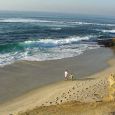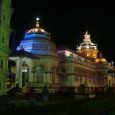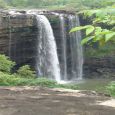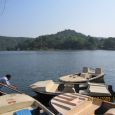Goa
Advertisement
By Air
One reach Goa very easily as it is linked via flights to all major cities in India like Delhi, Mumbai, Trivandrum, Pune, etc. as well as some international destinations in UK and Gulf countries. The Dabolim Airport located near the town of Vasco Da Gama is Goa's exclusive airport and can be reached from any place in Goa by hiring local transport.
By Rail
Goa has a well planned system of railways and commendable railway tracks. India's all important and major metro cities are connected to Goa through railways. The Konkan railway line has considerably reduced the traveling time to Goa and connects Goa to major cities like Delhi, Mumbai, Trivandrum, etc.
By Roads
Goa has a well planned road system that helps people reach Goa from nearby states. One can reach Goa via roads from places like Bangalore, Pune, and Mumbai. Goa also has three national highways that pass through which include NH - 4A, NH -17 and NH -17A. One can hire interstate buses that are run by Government owned tourist corporations or private cabs from nearby places to reach Goa.
By Sea
Goa is situated on the west coast of India and has the vast sea flanking its border. You can choose from the various cruises that are available from Mumbai and take tourists to Goa. During the monsoons however, the service is withdrawn temporarily due to the erratic behavior of the sea.
Advertisement
Anjuna Beach
Anjuna Beach in GoaWith its fluorescent painted palm trees and infamous full moon parties, ANJUNA, 8-km west of Mapusa, is Goa at its most "alternative". Designer leather and lycra may have superseded cotton Kaftans, but most people's reasons for coming are the same as they were in the 1970s: dancing and lying on the beach slurping tropical fruit. While browsing in the area have a day trip to the famous flea market.
One of the main sources of Anjuna's enduring popularity as a hippy hang out is its superb beach. Fringed by groves of swaying coconut palms, the curve of soft white sand conforms more closely to the archetypal vision of paradise than any other beach on the north coast. Bathing is generally safer than at most of the nearby resorts, too, especially at the more peaceful southern end, where a rocky headland keeps the sea calm and the undertow to a minimum.
North of the market ground, the beach broadens, running in an uninterrupted kilometre long stretch of steeply shelving sand to a low red cliff. The village bus park lies on top of this high ground, near a crop of small cafes, bars and Kashmiri handicraft stalls. Every lunch hour, tour parties from Panjim pull in here for a beer, before heading home again, leaving the ragged army of sun weary westerners to enjoy the sunset.
Colva Beach
Till few years back, before the beach resorts had not made their foray on Colva beach, it was an easy escape for those seeking ultimate solitude. Thankfully, the development in the past few years has been pretty fast paced making Colva southern Goa's main tourist beach. Nevermind the activity, Colva still has miles of virgin territory laced with soft white sand for you to explore.
Colva is forty kilometres from Panaji, the Goan capital and two kilometres from Benaulim. Adjacent to Colva is its secret suburb, Sernbatim beach. Longest among all beaches in Goa, Colva stretches twenty kilometres along the Arabian sea, about six kilometres west of Margao. Lined with coconut palms throughout, Colva has Bogmalo in north and Cabo de Rama in south. In the pre colonial era, Colva had the honour of being the retreat zone of Margao's high society. While speaking of history of Colva, the name of Our lady of Mercy Church invariably comes up. More about the church in the later paragraphs.
While at Colva one can also see the beautiful houses and villas that dot the village. Another interesting thing about Colva is its popularity among the locals. Though the beach is fairly famous with foreign and Indian tourists, it is the locals who can be seen here in large numbers.
Fort Aguada
Fort Aguada, the largest and most well preserved fort in Goa today is the most prized and crucial fort of Portuguese. The fort is so large that it envelops the entire peninsula at the south western tip of Bardez. Situated atop the Sinquerim plateau in Bardez Taluka, overlooking the vast expanses of Arabian Sea, the fort marked a reference point of ships. Built on the mouth of river Mandovi, it was strategically located and was the chief defence of Portuguese against the Dutch and Marathas.
The fort got its name 'Aguada' from the word Aguada (Portuguese for water), because of the three fresh water springs inside it. Built in 1612, it was once the grandstand of 79 cannons, a moat around the fort also protected it.
As you move around and inside this fort, it opens itself to you layer by layer and you can't help getting fascinated about the poweress it had once exulted. Some of the interesting features you will come across in the fort are a lighthouse which once housed a gigantic bell, an enormous vaulted cistern that could store ten million litre fresh water, and a prison in the basement interestingly the largest in Goa.
Mayem Lake
Thirty five kilometres from Panaji, is this artificial lake nestled among the greenery of hills and soaked in freshness. A visit to this lake will also get you closer to the rural life of Goa. Better still, move around the lake on foot and you will discover cottages hidden in the slopes of the hills. If you fall in love then cottages are available for rent purposes also. Facility of boating is also available.
Bondla National Park
Goa, a land of surprises does not disappoints anyone. Blessed by mother nature, its rich flora and fauna is a major tourist attraction. A break from the beaches and parties in the sanctuaries amidst the flora and fauna is a pleasant change. The beautiful jungles are well preserved by the environment concerned people and government. A trip along the western ghats will lay bare in front of you the secrets that Goa preserves within its thick green carpet.
Twenty percent of Goa is covered by wildlife protected areas, digging a little deep into the jungles or by estuaries will only reveal more . Not to forget the birds, Goa is a favourite of the a wide species of birds and many avid bird watchers throng the river sides and jungles to catch glimpses.
So So it's not just the 'wild' parties but a rich wildlife that waits you in Goa. Whenever you feel like coming close to nature, just visit one of the wildlife sanctuaries. But if you are seriously interested in wildlife and it is not just a change you are seeking from the beaches, then patience is the key word for you. Take an accommodation in or around a sanctuary in nature's bounty and feel the communion with the nature.
Shantadurga Temple
The beauty of Goa is further accentuated by the auspicious presence of various Gods and Goddesses. The Shantdurga Shrine located within dense forests presents a serene and exquisite picture to the tourists in Goa. Situated right at the edge of the forest the temple has a vast expanse of paddy fields in the front.
The temple has beautifully carved interiors where the marble and glass chandeliers cover and protect the silver work which has been artfully designed and dedicated to the Goddess. The sanctum houses idols of Devi Shantadurga flanked by the Lords Vishnu and Mahadev on either side. The 8 day long Zatra (procession) on wooden chariots is a must see attraction of the temple.
Information not available
Information not available
Advertisement








